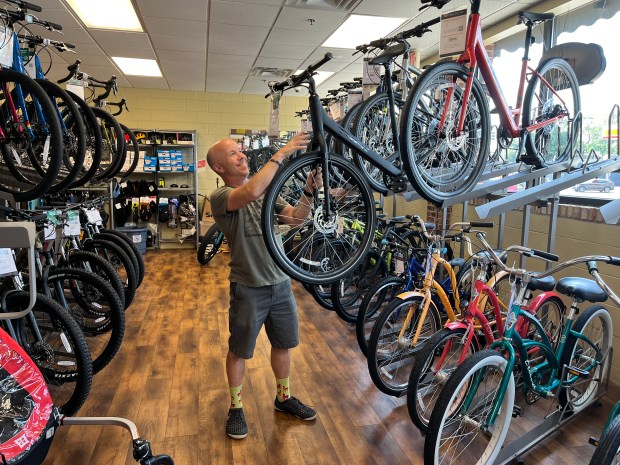A fatal bicycle crash near Country Club Hills in late May heightened concerns among bike safety advocates about the need for improved bicycle safety infrastructure in the south and southwest suburban region.
Steven Bender, a 73-year-old resident of Tinley Park, was cycling on 175th street May 29 when a collision with a vehicle took his life, according to the police report.
The crash was close to 4 miles from Bender’s home and a route Steve Buchtel, sales manager at GoodSpeed Cycles in Homewood, said Bender knew well.
Buchtel said Bender was an avid cyclist who frequently rode on 175th Street to get to Homewood, where he often visited GoodSpeed Cycles.
Police reports show the crash was on 175th Street near Interstate 57.
Buchtel said many major roads in the suburban area do not have sidewalks or bike paths forcing cyclists to use shoulders.
“The 175th Street has lower traffic, but it’s not accommodating to cyclists or pedestrians and that intersection doesn’t even acknowledge that cyclists and pedestrians exist,” Buchtel said. “And that’s true of a lot of those arterial road intersections in our region.”
Buchtel said Bender always took precautions when he was cycling, such as dressing in high-visibility clothing and maintaining lights on his bike.
“He was doing the things that we expect cyclists to do, to share streets with cars,” Buchtel said.
In 2022, 35 cyclists were killed in motor vehicle crashes, according to the Illinois Department of Transportation’s most recent annual report on crash data. Apart from fatalities, there were 2,513 bicycle-involved crashes that caused either property damage or minor to severe injuries.
In urban areas, most crashes occur on arterial and local roads, according to the report.
Victoria Barrett, senior planner at the Chicago Metropolitan Agency for Planning’s policy and implementation division, said the number of pedestrians and bicyclists killed in traffic crashes in the northeastern Illinois region is increasing.
Barrett said the main reason many counties lack better pedestrian and bike infrastructure is because federal and state transportation standards have prioritized vehicular travel since the inception of the transportation network in the 1950s.
Now, Barrett says municipalities must decide whether to prioritize bicycle and pedestrian safety through infrastructure improvements.
“The motivation, you know, it’s somebody raising their hand and saying, can we have some help with this?” Barrett said.
Dave Simmons, executive director of Ride Illinois, a nonprofit bicycle advocacy group, said data on bicycle-related crashes is inconsistent.
“There’s a serious gap in the reports of crashes and minor injuries because they don’t typically get reported,” Simmons said.
Simmons said a lack of proper infrastructure like bike lanes, speeding and distracted driving are all factors that contribute to bicycle-related crashes, but the only information available is from crash reports which contain the driver’s perspective, but not the cyclist who died in the accident.
Until recently, Buchtel, who also worked for the Active Transportation Alliance, said when the Cook County Highway Department or the Illinois Department of Transportation was building or reconstructing roads for cars, these projects often did not include sidewalks or paths for pedestrians and cyclists.
When communities requested these amenities to connect people to businesses, schools and other places, the agencies would agree to reserve space but shift the financial burden of actually building them onto the communities, Buchtel said.
This was because Illinois policy dictated that when a state road is being built, municipalities had to pay 20% of the cost for adding walking and biking infrastructure.
Buchtel said this cost-sharing practice made it difficult for communities with limited budgets to fit the bill.
In 2021, Illinois did away with cost-sharing after a bill passed requiring the state to cover the entire cost of walking and biking infrastructure when it’s needed on state roads.
Despite legislation changes, Buchtel said residents are still facing transportation challenges left behind from decades of road projects that did not prioritize cycling or walking.
“The projects they did 10 years ago, 20 years ago, 30 years ago, those are still the majority of projects that we have to live with,” Buchtel said.

Simmons said while there is a need for data that identifies intersections or roads where most accidents take place, action is often not taken until a fatality occurs.
“Our society is pretty reactive when it comes to these things being crashes, injuries …so having a plan that might identify where the dangerous intersections are based on either actual data or anecdotal input from residents is really the first step a lot of times,” Simmons said.
IDOT finalized a complete streets policy in 2010 that mandates when planning roads, agencies must consider bicycles and pedestrians. The law requires agencies add bike paths when they build new roads or fix old ones within a mile of urban areas.
Some of the infrastructure improvements outlined in the policy include the addition of an 8- to 10-foot wide shared use path, a 5-foot wide sidewalk and pedestrian countdown signals at traffic stops.
Many south and southwest suburban municipalities created plans to improve bike and pedestrian infrastructure after IDOT’s complete streets policy in 2010, but Barrett said funding and prioritization needs have hindered implementation.
Still, some villages are taking measures to improve street safety.
Blue Island became the first municipality in Illinois to adopt a complete streets policy as a local ordinance in 2011. As part of the new initiative to prioritize cyclist and pedestrian safety, Blue Island completed a resurfacing project on New Street that included improved sidewalks, crosswalks and back-in parking spaces that require drivers to look back at the sidewalk before backing in.
Flossmoor was awarded nearly $1.2 million in grant money in 2023 for the city’s downtown streetscape project, where the city plans to realign crosswalks, create curb extensions for safer crossing and truck aprons for safer turning movements.
Lindsay Bayley, program lead in CMAP’s Planning division, said adding bump-outs, or curb extensions, can have a significant impact on the safety of walkers and cyclists.
Bayley said since Hoboken, New Jersey, added curb extensions to each intersection, the city has not had a single traffic fatality in over five years.
Homewood received grant funding in 2022 for a Dixie Highway resurfacing project that will reduce the main traffic lanes, add turn lanes at intersections and install bicycle lanes in each direction.
Still, Buchtel said he hopes municipalities will stop viewing fatal bicycle-involved accidents as isolated incidents.
Buchtel said decreasing speed limits or warning against distracted driving are not solutions because the problem comes from how the roads were designed.
“The way our transportation system works on the roads is a result of how they were designed,” Buchtel said. “They were doing the engineering for a dangerous situation that threatens people, and that’s what they got.”
smoilanen@chicagotribune.com




